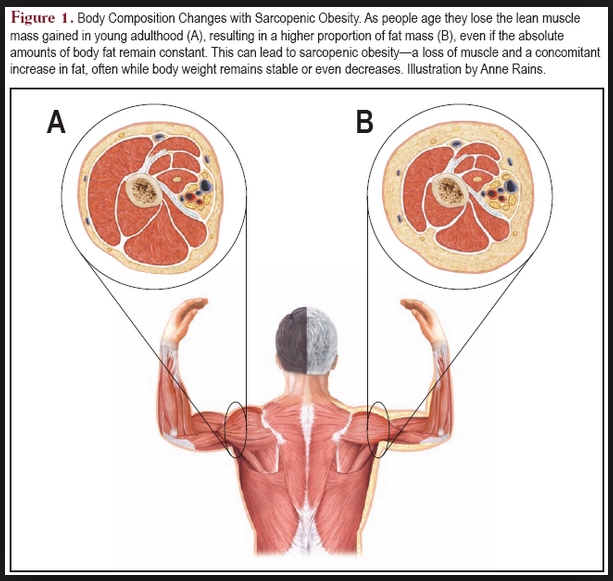
Sacopenia is the progressive loss of muscle mass, function, quality, and strength related to the aging process. When the word aging comes mind most people think of 65 plus, however you can start to lose muscle mass in your 30s. Actually, between the ages of 30 to 60, the average adult will gain 1 lb of weight and lose 1/2 lb of muscle yearly. That’s a gain of 30 lbs of fat and a loss of 15 lbs of muscle over a 30 year period.
How does this happen? Beginning in their mid-30s most people start to lead a more sedentary lifestyle. They have careers, get married, have children, and lead less physically active lives. Your body is designed to be physically active, and the old saying “use it or lose it” is the truth when it comes to your body, especially your muscle mass.
Why do you gain body fat and when you lose muscle? Muscle is the component of your body that is active and burns the most calories. Muscle mass burns calories while you are at rest just to maintain itself, even when you are asleep. A pound of muscle burns approximately 6 calories per day even if you are doing nothing but resting and it burns more if you are active. Your muscles favorite fuel to burn during times of rest and moderate activity is body fat.
On the other hand, body fat is designed to be used by your body in times of famine. It is encoded in your body to store body fat just in case you had to go without food for several days. Consequently body fat only burns about 1 calorie per day to maintain itself. So, you can see over time as you lose your muscle mass you lose your capacity to burn the calories you consume at the highest level. Other words, your metabolism drops in relation to your muscle loss.
What can be done to prevent sacopenia? Research shows the two most important things your can do to prevent muscle loss as you age is regular strength training (also known as weight lifting), and consuming the proper amount of protein high quality protein at each meal.
2 to 3 strength training sessions each week elicits an anabolic response in your muscles (repair and growth) causing your body to adapt to the increased demand to the resistance you are lifting. And getting enough protein at breakfast, lunch, and dinner signals the body that it is okay to use the protein to rebuild and repair your muscles thus, maintaining your muscle mass. Experts now agree that 25 to 30 grams of high quality protein at each meal is needed to maximize muscle growth and repair.